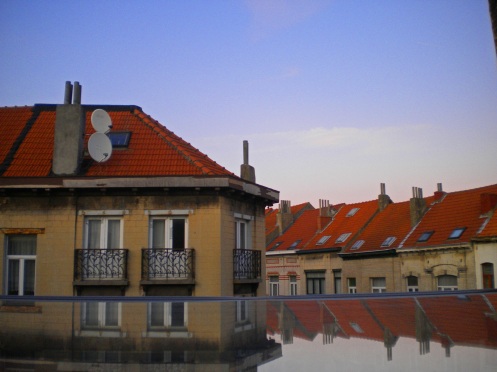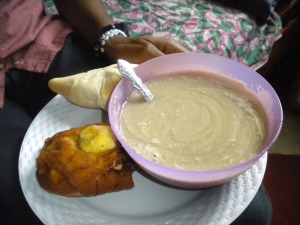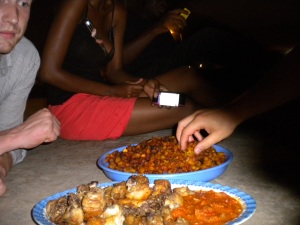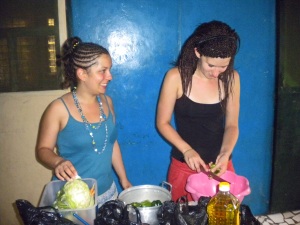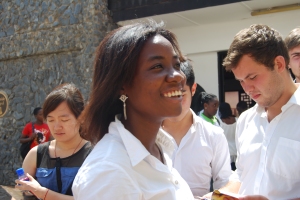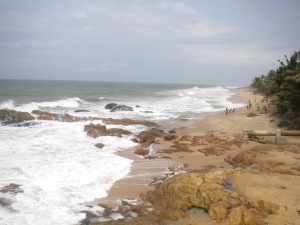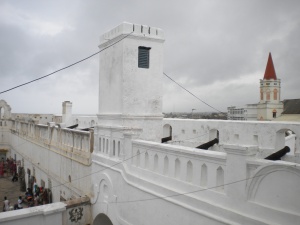Red Roofs
•October 31, 2011 • Leave a CommentRed roofs and long chimneys is what I see when I look outside the little roof window of my room. Three weeks have passed and I barely spent time in my room because of work, events and evening plans with friends. Even though this is a welcomed excuse not to spend time in my room – where it is slowly getting colder due to the missing heating- I still like y room, especially due to my decoration skills =).
The missing heating is the only thing besides the Bus #59 and my roomies that connects my home to the working place here (the heating in the office,too, is out of work at the moment!). Other than that, Brussels neighborhoods are so diverse that I feel in another world when I leave my Bus at Maelbeek every morning.
I live in the north of Brussels, in Schaerbeek. It is a neighborhood with a large Turkish and Northern-African population. When I visited my room, the big square in front of the house was filled with head-scarfed women and their children playing in front of the swimming pool. I saw a couple of men gathering at one side of the square, but they meet rather in the bars, teehouses and clubs where again the sight of women is rare. There are mostly small, cute row houses. Most of them seem older, in fact the only new building is the 30 story apartment tower rising at one side of the square. At first I felt a little bit misplaced, but by now I am used to the atmosphere and I feel comfortable. There are many families living around here and when i wait for the bus in the morning, the children of the elementary schools in the area line up in front of the swimming pool across the street for their morning swimming lessons. I love especially the big park just around the corner, a little patch of the claimed 15% of green-space in the city.
The Heart of Europe
•October 16, 2011 • Leave a CommentTwo weeks ago we just had a little Ghana-Maastricht-Reunion and I was still commuting to Brussels in search of a room. Today, I am sitting in my little apartment in the Belgian capital, having one of eight weeks of the internship in the European Parliament already finished.
The weeks between the internships I enjoyed at home, readjusting to the culture, visiting friends and family and starting to organize the coming year. It was a great transition time. I enjoyed the moments with my friends at home but also I got to see my roomies from my year in France again and I traveled the East-German coastline for a week with Vittoria, Basti and Hendrik.
Last Friday I packed as much as I could carry and hopped on the train to Brussels. The city welcomed me with a cozy-rainy weekend, apparently the most common weather that I’ll have to deal with here in Brussels (the umbrella is always in my bag!). I spent the weekend organizing everything for my stay here, from decoration from my little attic-room to metro tickets and sim-card. Also, I was welcomed so nicely by my new housemates, including two Greeks who are also doing internships at the European Institutions.
On Sunday I then explored the (still rainy) city with Kevin, one of my housemates coming from the Bretagne. I did not know much of what to expect for the first day of the internship and excitement and tension occupied me during the evening so that I tried to read up on my whole studies of the last three years and current events – and failed.
Monday went well nevertheless, and during the whole week I’ve been getting insights to a world that I only knew from the news and television before. In this regard my experiences here are surprisingly close to the ones I made in Ghana.
The parliament consists of four buildings. They are connected by bridges, and only slowly do I stop getting lost in the chaos of floors, elevators, escalators and rooms. The Parliament actually forms a little world in itself – where the working space is combined with everything else you could need, from supermarkets and bookshops to banks, a big canteen, multiple coffee bars and a fitness centre. The work in the bureau is interesting and diverse and already during this week I saw and learned already so many different things – that I am sure the time here will fly by.
Cultural Lesson
•September 1, 2011 • Leave a CommentApart of all our traveling weekends, I experienced and learned most about the Ghanaian culture during my every-day life in Accra, especially from my roomie Sally, our neighbor, Aiesec coworker and friend Evans as well as our neighbors Bernice and Ben and their whole family.
A couple of weeks in my internship, Sally complained about my non-Ghanaian diet and put into her head to change my food-experience of the summer. From that day, I stopped only drinking tea and eating spaghetti soup and rice with hot sauce; she made sure I had a tick-off list of all Ghanaian dishes she could think of and at lunch she’d call me into our room to present the different dishes she had cooked or bought.
Typical Ghanaian food would be for example Banku with Okro soup, Omo-tuo with groundnut shoup, Fufu with light soup or palmnut soup, yam with Palava sauce, fried plaintains or Kenkey with fish.Naturally the food plays a big role in everyday life and it was interesting and after a while even very tasteful getting to know the national dishes.
We also learned the big role religion plays in the Ghanaian society. Not only because most shops carry names such as God our Savior but especially because our friends went to church sometimes multiple times per week but surely each Sunday for the two-hour service and because conversations turned around this topic much more often than I am used to from Germany. It was exciting to experience the way Ghanaians celebrate their sunday service, including at least one hour of dancing and singing.
Even though Christianity and Islam are the main religions in Ghana nowadays, the traditional believes remain to be important to the Ghanaians. On August 12 it was the twin-festival in Jamestown, Accra, which a couple of us interns went to with our neighbors. It is the day to celebrate all twins and their families. The twins have to carry big bowls filled with herbs and lamb to a lagoon. It represents the bad spirits which have to be poured into the water. Afterwards the families and friends and the whole community celebrate the successful disposal of the bad spirits in a big street festival.
One day after this festival in Accra, the traditional thanksgiving for the end of the drought was celebrated at the local village of our neighbors, which we attend as well, in our new, tailored traditional clothes . The royal family and the elders of the community gathered in the palace of the village and after a round of welcome to the guests and a lot of talking in Twi which we did not understand, a traditional meal was eaten after a share of it had been dropped on the floor for the ancestors. This ritual was repeated at every royal house of the village which were seven in total, so that the ceremony, fascinating in the beginning, was becoming quite repeating towards the end.
I also experienced so much more of the country, little things that are so striking that they are hard to be recognized at times. For example, all the little shops and many houses are colored yellow, red and green, as they are used as advertising space for the biggest phone companies in the country: MTN, Vodafone and Glo. Most of the sewage system is open and the gutters are often choked so it does not only smell funny but one also has to pay constant attention not to trip and fall into one of those open drains. Also the women carrying food and water on their head and their children tied onto their back with a cloth is a common sight in the streets of Ghana, along with cool boxes containing plastic bags of cold drinking water, which, when empty, can numerously be found everywhere on the ground. It is also striking that Ghanaians don’t store anything but buy everything as they need it, which is why goods can be bought in the smallest portions all contained in little plastic bags. I’m sure there are many things I forget, as for example the level of noise that consistently exists, but I won’t be able to recall everything and I will leave you with this little taste of the Ghanaian culture.
Ada Foah & Dzita
•August 30, 2011 • Leave a CommentEven though I have already returned to Germany by now and enjoy my time at home, I want to give you the last impressions I got during our weekend trips as well as during our discovery tours in Accra.
At the end of July, we spent the weekend exploring the south-eastern region, between the capital and Togo. Our first stop was Ada Foah, a small coastal town at the mouth of the river Volta, which is still part of the Greater Accra region and only a two-hour drive from the Aiesec house in Accra. We had a wonderful Friday afternoon at the Dreamland Beach Resort, our home for the night. We enjoyed the close but dirty beach, immense waves, good food and a cozy bonfire as it got dark. Saturday was one of the sunniest and nicest days during my stay in Ghana and we planned a boat trip through the Volta delta. After half an hour boat ride alongside the green riverbanks – passing wooden sailing boats as well as being passed by jet skis – we arrived at our first destination, a rum Island. Here, an aged Ghanaian islander explained the rum production from the island’s sugarcane. On the small land mass nothing was to be found except for the open-air rum factory, some mud houses and goats. Of course we had to taste the local specialty following our tour as well and afterwards headed towards our next destination: an island embedded between the Volta river and the Atlantic Ocean. In the late afternoon we had to leave this paradise-like place way too early, but we still had to travel further to stay the night further east, at Dzita.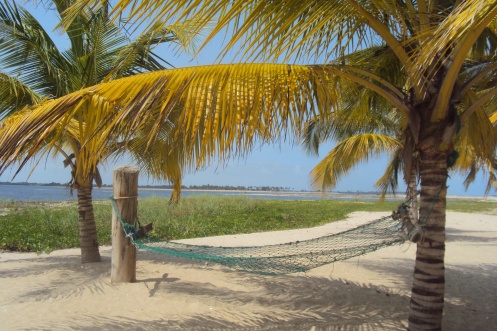
Our Sunday was just as perfect as the day before and even though we had been considering to see the lighthouse and forts around the area, we decided to enjoy the hours at the lagoon beach right by our hostel. As David and I went searching for eggs, that we had promised the owner of the hostel, we learned from the village people that we had slept too long to successfully end our hunt, but we did succeed in getting some coconuts instead. Christian, who works in Accra and was home for the weekend invited us into his courtyard and let his brother’s wife climb the coconut tree in the middle of the court to reach for some fruits for us. It was a nice little adventure tour through the neighbourhood before heading back to Accra in the late afternoon. Being held back once again to start traveling in time, just as on Saturday, we had to learn once more that in the early evening it was getting harder to get cheap transportation. Nevertheless, it was worth the extra hours we were able to spend in these paradisiacal spots.
Weekend in the Rainforest
•August 14, 2011 • Leave a CommentMany of our Ghanaian friends had told us about the beauty of the Volta-Region, a region to the north-east of Accra. Lake Volta is the largest lake in the world, and the Akosombo-Dam at its south end forms the largest elictricity donor in Ghana.
Since we only had two days to travel in the region, we headed directly north, to Hohoe, to visit the Wlee-falls. Hohoe is a small city which seems to be more directed towards tourism than other places in Ghana. There is a broad choice of hotels, also in our budget price range and the shops along the mainstreet show souvenirs for every taste. We still had to travel a bit outside of the city to get to the starting point of the waterfall-hike.
We love the guidebooks we have and almost follow them blindly since they are the only thing we have once travelling without locals. However, here in Hohoe we saw once more how wrong we could be: the book told us that it is best to go to the waterfalls without a guide, since the walk would be easy and the guide too expensive. After long minutes of discussion at the reception point, and realizing that the team would not let us go without a guide, we agreed and headed to the upper-Wlee-Falls. The hike started slowly, when we were crisscrossing the river in its valley. Soon enough however we started to climb the mountains, a total of 800 meters in altitude on a tiny, steep, entwined path and quickly we were more than happy to have our guide with us. At the foot of the mountain we all got bamboo-hiking-sticks and then our small, muscular, local guide went off jogging into the woods, showing us the way. We were all soaked before we had the first break after five minutes! Not only due to high humidity but also because of the steepness of the little trail through the forest the next five hours got to be the most excercise I have been doing in Ghana so far.During the two hour ascent to the waterfalls, we could finally see the Ghanaian rainforest! Even though no bigger animals live there, we saw many different kinds of insects and vegetation which our guide explained to us every once in a while. We were climbing the U-formed mountain to the right of the waterfalls and after reaching a certain altitude we had an amazing view to the waterfalls, over the valley, the mountains opposite of us and the little village where we had started our hike from. Also, the mountain we climbed builds the border between Ghana and Togo, and our guide told us about an adventurous two-day hike to the nearest village in the neighborcountry.
After this hike the six us were very tired and especially ready to eat and sleep. However, we had planned to travel further to reach another hotel more south. We did not get to Fume, the closest village of the Lodge we had chosen, until after sunset. Here, the tro-tro transportation got to its limits and ended and we were instead picked up by the hotel-owner by a 4by4 to bring us to the Mountain Paradise Lodge on a hill in the rainforest. We were riding on the back of the truck and it was the first time we really got to see the African stars, without the smog from Accra or the clouds of the rainyseason, and especially since there was no light surrounding us on our way up to the lodge.
Sunday morning we could then really see the amazing location of the lodge, overlooking a rainforest valley and mountains. It was thus basically chosen for us to just sit, read and dream the whole day at this place; and except for a little exploration hike into the near by mountain village we did not move at all until it was time to return to Accra in the afternoon.
Boti-Falls
•July 28, 2011 • Leave a CommentThis week we were finally able to present our workshop in the first school. Even though it was examination week for all students of public schools, the headmaster of the Bishop Daly Anglican School, gave us time after the morning assembly to teach the whole school on environmental problems in Ghana. I cannot estimate the amount of students that were sitting in the schoolyard to listen to us, but they sure were many! However, we did have microphones and thus it worked out quite well. The children were enthusiastic and participated in the question games we had prepared, which was a lot of fun.
On the same day as our first school experience, our Aiesec group left for a daytrip to the Boti-Falls, around three hours to the east of Accra. Once again, a completely new environment presented itself to us. Leaving the city in this direction, we drove up the mountains surrounding the capital, and we had a nice view on the city. From this point onwards the nature was hilly and filled with banana plantations. We got a view on the presidential residence, where also international diplomates are hosted when being in town. The Boti-Falls are about 30 meters high and were beautiful to look at. Since all of our travel books and our guide at the falls ensured us that swimming is allowed, we went swimming and climbed behind the waterfalls.
As we came back to Accra, a good-bye party for our two Macanese friends who left Ghana on Thursday had been organized. They were one of the first interns this summer in the Local Commitee Aiesec-Central University College, and it was sad to already having to say good-bye to them.
Tisu Tisu !
•July 22, 2011 • Leave a CommentAfter our workweek had been finished, we went to the Bojo-Beach just outside of Accra. In the course of the week we had grown to be around 25 interns at the Local Commitee, Aiesec Central University College. Twenty of us hired aTrotro and went on the beach half an hour away. The beach is an island separated from the mainland by a river. We spent a wonderful day in the sun, and it was the pure holiday – feeling.
On Sunday, we accompanied Sally, my roommate, to her church; the Qodesh Lighthouse Chapel. It is the headquarter of the lighthouse churches in the country and a very impressive, modern building. The main house is an immense white church with big circled windows, without glass, which let the wind go through to make it a little bit cooler inside. We sat on chairs while the service was held on a large heightened level. When we entered the service had already started but people were coming and leaving during the two hours as they wished. A choir was singing and the whole community was participating, standing or sitting, clapping, singing and smiling. Even though the preaching was partly very difficult to listen to for me, I enjoyed very much the atmosphere in the church, which was enthusiastic and happy.
In the afternoon, we visited the Art and Craft Market, which is in the neighborhood where also the ministries and the government are located. It was interesting to see the traditional Ghanaian crafts, and we even tried to bargain a bit by using our little knowledge of Twi, the traditional language in the Accra region. The most important words were surely tisu, meaning reduce the price and Daabi which means no. Also a friendly Me da si (thank you) made the sellers happy and maybe even a little bit more willing to bargain with the Obroni (white people).
To finish our free day, we started a little contra-programm and went to the Mall of Accra, had some Western food and watched Harry Potter.
Kakum National Park
•July 21, 2011 • Leave a CommentLast weekend we planned a day-trip to the Kakum National Park, one of the remaining areas of rain forest that are protected nowadays. The park is near Cape Coast, so we had quite some travelling to do during the day. The plan was to start early in the morning, take the mini-van again and come back in the early evening. However, we have experienced quite often now that time has a different meaning in Ghana. Even though we called our driver again early in the morning to make sure that he was on his way, he arrived with a two hour delay.
The National Park has been founded in 1990 and presents an extraordinary diversity of animals and plants. As nowadays only about twenty percent of the initial rain forest remains in Ghana, many endangered species live in the park. We arrived in the early afternoon and started our exploration of the forest with a guide. As I do not know very much about plants,I would not be able to say anything about its diversity. However, a striking fact was the height of all the plants that we saw. This was the more obvious when we entered the Canopy Walkway, a trail in the trees at a height of up to 45 meters, including 7 chain bridges over a length of 330 meters.
Even though, in the end, we had little time in the park, the trip was definately worth the hours we had to spent in the car.
Cape Coast
•July 12, 2011 • Leave a CommentBefore we set off for our weekend at Cape Coast, we had a good Nigerian breakfast, prepared by Anthonia. Noah and I had been in charge of getting the ingredients at the market on Thursday, but as it turns out we really had no idea and bought the wrong food. Instead of getting Yam, a potato like vegetable, just much bigger, we got Kasawa which to me looked alike but tastes quite different. While everybody else was sleeping in on our free friday Anthonia, Noah and I thus had to get back to the market to buy the right food.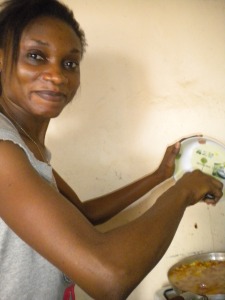
In the early afternoon we got started to go to Cape Coast. We had a nice air-conditioned mini-van where our whole group of twelve interns found place. It was the first time many of us got to leave the city and explore a little bit more of the country. Having left Accra and the traffic jams behind us, the green Ghanaian nature enfolded in front of us. We passed the hills, surrounding Accra and the many little villages along the coast. We were brought to the Aiesec house in Cape Coast and we were welcomed by the local team. It was already quite late but as we still wanted to explore the new place, they guided us through the city and to the beach. It was too good to feel the cold ocean wind after a week of city smog. We decided to get dinner at a nice beach restaurant, where even a show with traditional African dance was already waiting for us and giving our first vacation-day a perfect closure.
On Saturday we explored the Cape Coast Castle, one of the main slave-turning-points of the 17th to 19th century. The castle was beautiful and impressive. Looking over the sea and its white paint it was very inviting. That is, until we had the guided tour through the ancient cells for slaves, where they had to wait up to three month until they passed the „door of no return“ and entered the ships to the Americas and Europe. The small, stuffy, and dark cells stand again in extreme contrast to the light and wide rooms and resident halls of the English governors, ruling over the castle.
When the tour was finished, we decided to enjoy the Cape Coast beach for the rest of the day. We swam in the sea, enjoyed the sun and watched the rugby training of a highly motivated high school sports team.
Cape Coast showed me a different side of Ghana. Not only is it filled with sights of the country’s history but also much cleaner and organized than Accra. It is the ethical group of the Fanti who reside in this area. They have their proper language and culture and are especially known for their excellent knowledge of English, based on the importance of the region in times of the English colonialization.
We returned Sunday night and were surprised by new interns who had arrived during the weekend.

